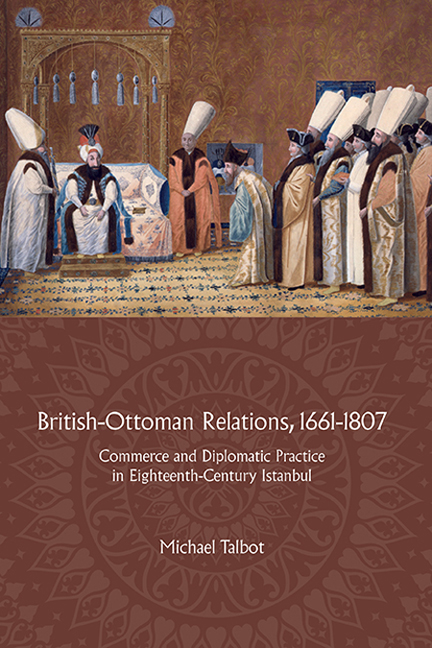 British-Ottoman Relations, 1661-1807
British-Ottoman Relations, 1661-1807 Book contents
- Frontmatter
- Dedication
- Contents
- List of tables and figures
- Acknowledgements
- Note on languages, place names, dates, and currencies
- List of abbreviations
- Introduction: De/re-constructing the history of British–Ottoman relations
- 1 The framework of relations
- 2 The office of ambassador
- 3 Trade and diplomatic finances
- 4 Gift-giving
- 5 Diplomacy as performance
- 6 Negotiating disputes
- Conclusions: De/re-constructing British–Ottoman diplomacy
- Bibliography
- Index
5 - Diplomacy as performance
Published online by Cambridge University Press: 29 July 2017
- Frontmatter
- Dedication
- Contents
- List of tables and figures
- Acknowledgements
- Note on languages, place names, dates, and currencies
- List of abbreviations
- Introduction: De/re-constructing the history of British–Ottoman relations
- 1 The framework of relations
- 2 The office of ambassador
- 3 Trade and diplomatic finances
- 4 Gift-giving
- 5 Diplomacy as performance
- 6 Negotiating disputes
- Conclusions: De/re-constructing British–Ottoman diplomacy
- Bibliography
- Index
Summary
Ceremonies and spectacle
The arrival of the Ottoman ambassador Yusuf Agah Efendi to London in early 1795 was marked by a number of official ceremonies. After being treated to speeches and ‘a cold collation’ at his residence, the ambassador processed to St James's Palace with his small retinue in a convoy of a dozen coaches accompanied by footmen and attendants, with a group of soldiers at the front clearing the way. They were received at the palace by a parade of soldiers, and the ambassador was escorted inside towards the main audience hall. Arriving at the door, he was flanked by the Lord Chamberlain on his right, and the Earl of Jersey on his left, and on entering the hall he made ‘three profound reverences’, which were acknowledged by the king. This moment was imagined in Mather Brown's painting, which aimed to provide a new image of the Ottoman place in the diplomatic world at the end of the eighteenth century, with the Ottoman ambassador bowing low in humility before a British monarch. After this, Yusuf Agah gave a speech that was translated by his own tercüman, and delivered his credentials to Lord Grenville, kissing it before handing it over. The king replied, and the ambassador withdrew, again making three reverences.
The use of such ceremonial in diplomatic practice provided a means of regulating relations performing rhetorical notions of geopolitics. The ceremonies that accompanied formal meetings between the British ambassadors and the sultan, grand vizier, and other officials were part of a carefully choreographed performance of the Ottoman world-view, albeit one sufficiently flexible that it changed over time. As with Ottoman conventions of gift-giving, the British did not always have a particularly positive view of those practices. However, as with gift-giving, it was necessary for the British to comply in order to ensure good relations with the Ottoman state. The idea of the actual display of friendship – iẓhār-ı muṣāfāt ve iḫlāṣ ve işʿār-ı meveddet (displays of amity and sincere friendship, and signs of amicability), to quote the British Capitulations – gave ceremonial a key role in physically articulating this important concept within the diplomatic framework. Moreover, public ceremonies were a means to maintain Britain's prestige in relation to the other resident European embassies.
- Type
- Chapter
- Information
- British-Ottoman Relations, 1661-1807Commerce and Diplomatic Practice in Eighteenth-Century Istanbul, pp. 141 - 172Publisher: Boydell & BrewerPrint publication year: 2017


